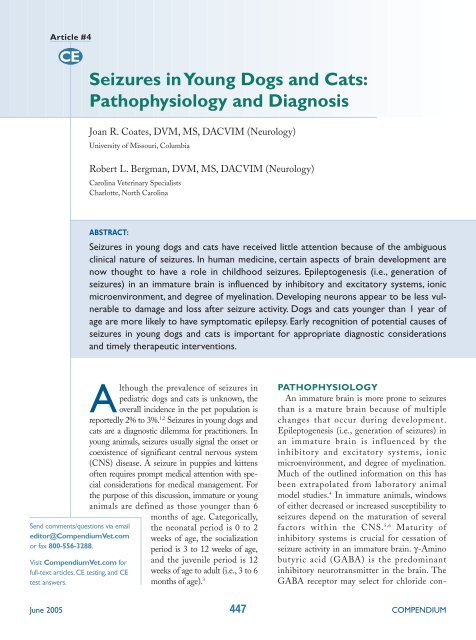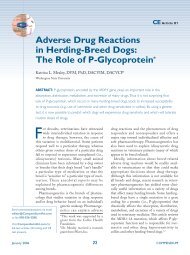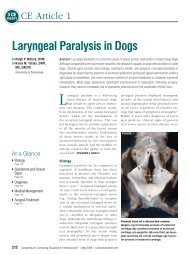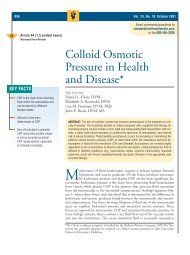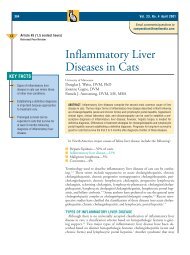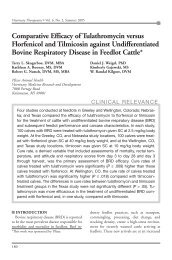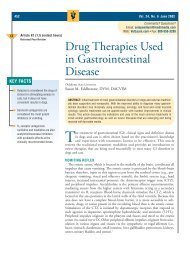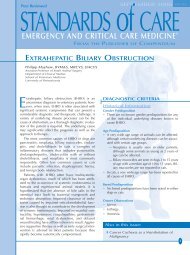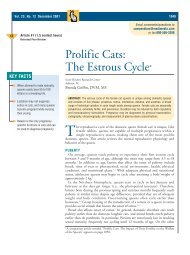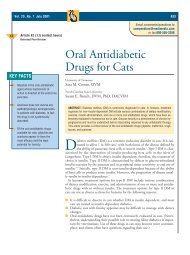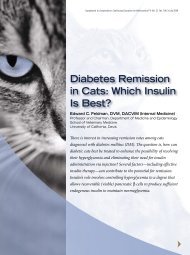Seizures in Young Dogs and Cats: Pathophysiology ... - VetLearn.com
Seizures in Young Dogs and Cats: Pathophysiology ... - VetLearn.com
Seizures in Young Dogs and Cats: Pathophysiology ... - VetLearn.com
Create successful ePaper yourself
Turn your PDF publications into a flip-book with our unique Google optimized e-Paper software.
Article #4<br />
CE<br />
Send <strong>com</strong>ments/questions via email<br />
editor@CompendiumVet.<strong>com</strong><br />
or fax 800-556-3288.<br />
Visit CompendiumVet.<strong>com</strong> for<br />
full-text articles, CE test<strong>in</strong>g, <strong>and</strong> CE<br />
test answers.<br />
<strong>Seizures</strong> <strong>in</strong> <strong>Young</strong> <strong>Dogs</strong> <strong>and</strong> <strong>Cats</strong>:<br />
<strong>Pathophysiology</strong> <strong>and</strong> Diagnosis<br />
Joan R. Coates, DVM, MS, DACVIM (Neurology)<br />
University of Missouri, Columbia<br />
Robert L. Bergman, DVM, MS, DACVIM (Neurology)<br />
Carol<strong>in</strong>a Veter<strong>in</strong>ary Specialists<br />
Charlotte, North Carol<strong>in</strong>a<br />
ABSTRACT:<br />
<strong>Seizures</strong> <strong>in</strong> young dogs <strong>and</strong> cats have received little attention because of the ambiguous<br />
cl<strong>in</strong>ical nature of seizures. In human medic<strong>in</strong>e, certa<strong>in</strong> aspects of bra<strong>in</strong> development are<br />
now thought to have a role <strong>in</strong> childhood seizures. Epileptogenesis (i.e., generation of<br />
seizures) <strong>in</strong> an immature bra<strong>in</strong> is <strong>in</strong>fluenced by <strong>in</strong>hibitory <strong>and</strong> excitatory systems, ionic<br />
microenvironment, <strong>and</strong> degree of myel<strong>in</strong>ation. Develop<strong>in</strong>g neurons appear to be less vulnerable<br />
to damage <strong>and</strong> loss after seizure activity. <strong>Dogs</strong> <strong>and</strong> cats younger than 1 year of<br />
age are more likely to have symptomatic epilepsy. Early recognition of potential causes of<br />
seizures <strong>in</strong> young dogs <strong>and</strong> cats is important for appropriate diagnostic considerations<br />
<strong>and</strong> timely therapeutic <strong>in</strong>terventions.<br />
lthough the prevalence of seizures <strong>in</strong><br />
pediatric dogs <strong>and</strong> cats is unknown, the<br />
overall <strong>in</strong>cidence <strong>in</strong> the pet population is<br />
reportedly 2% to 3%. 1,2 A<br />
<strong>Seizures</strong> <strong>in</strong> young dogs <strong>and</strong><br />
cats are a diagnostic dilemma for practitioners. In<br />
young animals, seizures usually signal the onset or<br />
coexistence of significant central nervous system<br />
(CNS) disease. A seizure <strong>in</strong> puppies <strong>and</strong> kittens<br />
often requires prompt medical attention with special<br />
considerations for medical management. For<br />
the purpose of this discussion, immature or young<br />
animals are def<strong>in</strong>ed as those younger than 6<br />
months of age. Categorically,<br />
the neonatal period is 0 to 2<br />
weeks of age, the socialization<br />
period is 3 to 12 weeks of age,<br />
<strong>and</strong> the juvenile period is 12<br />
weeks of age to adult (i.e., 3 to 6<br />
months of age). 3<br />
PATHOPHYSIOLOGY<br />
An immature bra<strong>in</strong> is more prone to seizures<br />
than is a mature bra<strong>in</strong> because of multiple<br />
changes that occur dur<strong>in</strong>g development.<br />
Epileptogenesis (i.e., generation of seizures) <strong>in</strong><br />
an immature bra<strong>in</strong> is <strong>in</strong>fluenced by the<br />
<strong>in</strong>hibitory <strong>and</strong> excitatory systems, ionic<br />
microenvironment, <strong>and</strong> degree of myel<strong>in</strong>ation.<br />
Much of the outl<strong>in</strong>ed <strong>in</strong>formation on this has<br />
been extrapolated from laboratory animal<br />
model studies. 4 In immature animals, w<strong>in</strong>dows<br />
of either decreased or <strong>in</strong>creased susceptibility to<br />
seizures depend on the maturation of several<br />
factors with<strong>in</strong> the CNS. 5,6 Maturity of<br />
<strong>in</strong>hibitory systems is crucial for cessation of<br />
seizure activity <strong>in</strong> an immature bra<strong>in</strong>. γ-Am<strong>in</strong>o<br />
butyric acid (GABA) is the predom<strong>in</strong>ant<br />
<strong>in</strong>hibitory neurotransmitter <strong>in</strong> the bra<strong>in</strong>. The<br />
GABA receptor may select for chloride con-<br />
June 2005 447 COMPENDIUM
448 CE<br />
<strong>Seizures</strong> <strong>in</strong> <strong>Young</strong> <strong>Dogs</strong> <strong>and</strong> <strong>Cats</strong>: <strong>Pathophysiology</strong> <strong>and</strong> Diagnosis<br />
ductance (GABA A) or potassium conductance<br />
(GABA B). 7 Ultrastructural studies <strong>com</strong>par<strong>in</strong>g immature<br />
with adult rat bra<strong>in</strong>s show that GABA term<strong>in</strong>als <strong>in</strong><br />
immature bra<strong>in</strong>s are smaller <strong>and</strong> conta<strong>in</strong> fewer synaptic<br />
vesicles. 8 Likewise, there are fewer synapses <strong>and</strong> lower<br />
concentrations of GABA receptors. 9,10 The rate of<br />
GABA formation <strong>and</strong> catabolism changes dur<strong>in</strong>g maturation.<br />
11–13 Differences lie not <strong>in</strong> receptor <strong>com</strong>position<br />
but rather <strong>in</strong> maturational changes to the chloride ion<br />
gradient that govern the equilibrium potential for<br />
GABA A channels. 14 Consequently, <strong>in</strong> the immature<br />
bra<strong>in</strong>, GABA A responses result <strong>in</strong> depolarization with<br />
subsequent activation of sodium ion (Na + ) <strong>and</strong> calcium<br />
ion (Ca +2 ) channels. 6<br />
In contrast to the <strong>in</strong>hibitory system, the excitatory<br />
system is overdeveloped. Glutamate is the major excitatory<br />
neurotransmitter <strong>in</strong> the bra<strong>in</strong>, <strong>and</strong> several subtypes<br />
for the glutamate receptor exist, <strong>in</strong>clud<strong>in</strong>g N-methyl-Daspartate<br />
(NMDA), ka<strong>in</strong>ate, <strong>and</strong> α-am<strong>in</strong>o-3-hydroxy-5methyl-4-isoxazoleproprionate<br />
(AMPA). 15,16 The<br />
hippocampus of the prenatal bra<strong>in</strong> has an excess number<br />
of recurrent excitatory synapses <strong>and</strong> an overabundance<br />
of NMDA receptors. 17 As the bra<strong>in</strong> cont<strong>in</strong>ues to<br />
develop, these excitatory synapses are modulated or<br />
“pruned” to adult levels. Expression of glutamate transporters<br />
that play a role <strong>in</strong> glutamate uptake is also developmentally<br />
regulated. Decreased expression of<br />
glutamate transporters <strong>and</strong> variation of subtypes can<br />
lead to <strong>in</strong>creased seizure susceptibility <strong>and</strong> to a lower<br />
seizure threshold. 5,18<br />
Differences <strong>in</strong> the ionic microenvironment that surrounds<br />
neurons <strong>and</strong> glial cells also contribute to epileptogenicity<br />
of the immature bra<strong>in</strong>. The potassium<br />
concentration is <strong>in</strong>creased <strong>in</strong> the extracellular fluid of<br />
immature bra<strong>in</strong>s. 5 Glial function immaturity may allow<br />
the extracellular potassium concentration to <strong>in</strong>crease,<br />
caus<strong>in</strong>g excitability. 4 Thus the action potentials <strong>in</strong> immature<br />
neurons last longer because of altered potassium<br />
channel conductance, thereby caus<strong>in</strong>g a lower rest<strong>in</strong>g<br />
membrane potential <strong>and</strong> <strong>in</strong>creased neuronal excitability. 19<br />
Catecholam<strong>in</strong>es, especially norep<strong>in</strong>ephr<strong>in</strong>e, play a role<br />
<strong>in</strong> the generalization of epileptic activity dur<strong>in</strong>g k<strong>in</strong>dl<strong>in</strong>g.<br />
Lower levels of norep<strong>in</strong>ephr<strong>in</strong>e have been associ-<br />
ated with loss of k<strong>in</strong>dl<strong>in</strong>g antagonisms. 4 K<strong>in</strong>dl<strong>in</strong>g is<br />
def<strong>in</strong>ed as local, repeated, <strong>and</strong> <strong>in</strong>itially subconvulsive<br />
stimulation of neurons that progresses to alter the<br />
excitability of other nearby neurons <strong>and</strong> to develop <strong>in</strong>to<br />
a seizure focus. The threshold of k<strong>in</strong>dl<strong>in</strong>g varies with<br />
age, <strong>and</strong> spontaneous seizures occur more readily <strong>in</strong><br />
develop<strong>in</strong>g animals than <strong>in</strong> adults. 6 The lower ep<strong>in</strong>ephr<strong>in</strong>e<br />
level <strong>in</strong> the immature bra<strong>in</strong> may be a factor responsible<br />
for facilitat<strong>in</strong>g k<strong>in</strong>dl<strong>in</strong>g. 4<br />
In<strong>com</strong>plete myel<strong>in</strong>ation contributes to seizure expres-<br />
Developmental changes <strong>in</strong> the bra<strong>in</strong> may <strong>in</strong>crease or decrease<br />
the w<strong>in</strong>dow of susceptibility for seizures <strong>in</strong> young dogs <strong>and</strong> cats.<br />
sion <strong>in</strong> young animals. Myel<strong>in</strong>ation of the CNS beg<strong>in</strong>s<br />
<strong>in</strong> the last stage of gestation <strong>and</strong> cont<strong>in</strong>ues more rapidly<br />
after birth. It occurs first <strong>in</strong> phylogenetically older<br />
regions of the bra<strong>in</strong> <strong>and</strong> bra<strong>in</strong> stem <strong>and</strong> later <strong>in</strong> the corpus<br />
callosum <strong>and</strong> neocortex. 20 It is speculated that this<br />
may have a role <strong>in</strong> poor <strong>in</strong>terhemispheric synchrony of<br />
seizure discharges. 4<br />
Can seizures cause bra<strong>in</strong> damage to the immature<br />
bra<strong>in</strong>? In humans, the neonatal CNS is particularly susceptible<br />
to seizures. 21 However, the immature nervous<br />
system is no more vulnerable <strong>and</strong> possibly more resistant<br />
to damage aris<strong>in</strong>g from seizures. 22 The immature bra<strong>in</strong><br />
undergo<strong>in</strong>g convulsive activity is capable of tak<strong>in</strong>g care<br />
of <strong>in</strong>creased energy requirements through acceleration<br />
of glycolytic flux, thus avoid<strong>in</strong>g major disruptions <strong>in</strong><br />
oxidative metabolism. 22 Cerebral high-energy phosphates<br />
(i.e., ATP <strong>and</strong> ADP) have been preserved <strong>in</strong><br />
puppies with seizures. 23 Nuclear magnetic resonance<br />
spectroscopy studies of the bra<strong>in</strong>s of puppies with<br />
seizures receiv<strong>in</strong>g supplemental oxygen have also shown<br />
sufficient preservation of energy balance even after prolonged<br />
status epilepticus. 24<br />
Develop<strong>in</strong>g neurons are less vulnerable to neuronal<br />
damage <strong>and</strong> cell loss. 6 Thus the immature bra<strong>in</strong> appears<br />
to be more resistant to the toxic effects of glutamate<br />
than does the mature bra<strong>in</strong>. 25 NMDA receptor expression<br />
<strong>in</strong> neonatal rat pups shows a decreased response to<br />
glutamate associated with differences <strong>in</strong> receptor subtypes,<br />
thus <strong>in</strong>dicat<strong>in</strong>g that the degree of calcium entry<br />
<strong>in</strong>to the neurons is directly related to age. 26 This may be<br />
partly due to the lower density of active synapses, lower<br />
use of energy substrates, <strong>and</strong> immaturity of biochemical<br />
cascades that subsequently cause cell death. 26,27 How-<br />
COMPENDIUM June 2005
ever, there is <strong>in</strong>creas<strong>in</strong>g evidence that recurrent seizures<br />
affect neuronal development by mechanisms that alter<br />
synaptogenesis <strong>and</strong> neurogenesis. 6,28<br />
The long-term effects of cont<strong>in</strong>ued seizure activity are<br />
unknown. Neonatal seizures can <strong>in</strong>crease the susceptibility<br />
of the develop<strong>in</strong>g bra<strong>in</strong> to subsequent seizure<strong>in</strong>duced<br />
<strong>in</strong>jury. 29,30 Experimental studies of immature<br />
rats showed that various pathologic changes developed<br />
after 50 short seizures. 31 Histopathologic studies of<br />
epileptic beagles have shown evidence of astrocytic<br />
swell<strong>in</strong>gs <strong>and</strong> ischemic changes <strong>in</strong> cerebral cortical neurons.<br />
32 Magnetic resonance imag<strong>in</strong>g (MRI) of the bra<strong>in</strong><br />
has shown reduced myel<strong>in</strong>ation <strong>in</strong> children who have<br />
had neonatal convulsions. 21,33 However, a recent analysis<br />
of humans with recurrent seizures concluded that the<br />
risk to develop<strong>in</strong>g <strong>in</strong>dividuals was low. 34<br />
CLASSIFICATION<br />
Classify<strong>in</strong>g seizures is useful <strong>in</strong> identify<strong>in</strong>g the type<br />
<strong>and</strong> determ<strong>in</strong><strong>in</strong>g an underly<strong>in</strong>g cause. In humans, controversy<br />
exists over def<strong>in</strong><strong>in</strong>g a solitary classification<br />
scheme for cl<strong>in</strong>ically describ<strong>in</strong>g seizures <strong>in</strong> neonates.<br />
The scheme used <strong>in</strong> adults established by the International<br />
League Aga<strong>in</strong>st Epilepsy 35 has been unreliable<br />
<strong>and</strong> difficult to apply to <strong>in</strong>fants. 36 Important differences<br />
exist <strong>in</strong> the cl<strong>in</strong>ical expression of seizures <strong>in</strong> adults <strong>and</strong><br />
neonates. 37 Adults more <strong>com</strong>monly present with partial<br />
seizures, whereas neonates have postural abnormalities.<br />
Neonatal seizures are often described as subtle <strong>and</strong> fragmentary,<br />
<strong>and</strong> some neonatal behaviors can mimic the<br />
phenomenology of true seizures. 38 These seizure-like<br />
behaviors have been referred to as reflex or release phe-<br />
nomena <strong>and</strong> must be dist<strong>in</strong>guished from true seizures.<br />
Neonatal seizures are currently classified us<strong>in</strong>g electroencephalography<br />
<strong>and</strong> simultaneous video monitor<strong>in</strong>g.<br />
Neonatal seizures have been described as seizures with a<br />
close correlation to electroencephalogram (EEG)<br />
seizure discharges, seizures with an <strong>in</strong>consistent or no<br />
relationship to EEG ictal discharges, <strong>in</strong>fantile spasms,<br />
<strong>and</strong> EEG seizures without cl<strong>in</strong>ical seizures. 39 This has<br />
led to classification of epileptic <strong>and</strong> nonepileptic neona-<br />
<strong>Seizures</strong> <strong>in</strong> <strong>Young</strong> <strong>Dogs</strong> <strong>and</strong> <strong>Cats</strong>: <strong>Pathophysiology</strong> <strong>and</strong> Diagnosis CE 449<br />
tal seizures with further categorization accord<strong>in</strong>g to<br />
cl<strong>in</strong>ical features (i.e., focal clonic, focal tonic, or<br />
myoclonic seizures; spasms). 40,41<br />
A classification scheme for seizures accord<strong>in</strong>g to their<br />
cl<strong>in</strong>ical appearance <strong>in</strong> domestic animals has not been<br />
thoroughly def<strong>in</strong>ed, <strong>and</strong> currently used schemes are<br />
extrapolated from the human literature. 42,43 In veter<strong>in</strong>ary<br />
medic<strong>in</strong>e, seizure types are classified <strong>in</strong>to two major categories:<br />
generalized <strong>and</strong> focal. 44 A generalized seizure<br />
often reflects a widespread seizure focus, produc<strong>in</strong>g loss<br />
of consciousness, autonomic activity, <strong>and</strong> whole body<br />
movements with alternat<strong>in</strong>g tonic <strong>and</strong> clonic phases of<br />
movements. A focal seizure reflects the activity of a local<br />
seizure focus <strong>in</strong> an area produc<strong>in</strong>g motor activity. It has<br />
been believed that generalized motor seizures are the<br />
most <strong>com</strong>mon seizure type <strong>in</strong> dogs. 42,45,46 This has<br />
recently been brought <strong>in</strong>to question by Berendt <strong>and</strong><br />
Gram 47 who applied a human classification scheme for<br />
epilepsies to dogs. Results showed that focal seizures<br />
with <strong>and</strong> without generalization were most <strong>com</strong>mon<br />
<strong>and</strong> further emphasized reevaluation of currently used<br />
term<strong>in</strong>ology for epilepsy <strong>in</strong> veter<strong>in</strong>ary medic<strong>in</strong>e. In puppies,<br />
generalized tonic seizures have been observed as<br />
early as 4 weeks of age. 48 Immaturity of the bra<strong>in</strong> <strong>and</strong><br />
neurotransmission processes may prevent more accurate<br />
recognition of seizures <strong>in</strong> younger animals.<br />
CAUSE<br />
Recurrent seizures are more broadly def<strong>in</strong>ed as epilepsies.<br />
Podell et al 42 adopted a nomenclature scheme from<br />
human epilepsies based on identifiable cause. Primary<br />
epileptic seizure (i.e., idiopathic) is the term used if an<br />
<strong>Seizures</strong> <strong>in</strong> young dogs <strong>and</strong> cats often reflect a symptomatic or an<br />
acquired cause; however, idiopathic epilepsy is be<strong>in</strong>g recognized<br />
more frequently as a diagnostic differential <strong>in</strong> younger animals.<br />
underly<strong>in</strong>g cause cannot be identified. If seizures result<br />
from a structural lesion, they are def<strong>in</strong>ed as secondary<br />
epileptic seizures. The term reactive epileptic seizure is used<br />
when there is a reaction of the normal bra<strong>in</strong> to transient<br />
systemic <strong>in</strong>sult or physiologic stresses; these seizures are<br />
not considered recurrent. Epilepsies are also described as<br />
asymptomatic (i.e., primary, idiopathic) <strong>and</strong> symptomatic<br />
(i.e., secondary). 49 This article uses the term<strong>in</strong>ology<br />
of asymptomatic <strong>and</strong> symptomatic epilepsies.<br />
June 2005 COMPENDIUM
450 CE<br />
<strong>Seizures</strong> <strong>in</strong> <strong>Young</strong> <strong>Dogs</strong> <strong>and</strong> <strong>Cats</strong>: <strong>Pathophysiology</strong> <strong>and</strong> Diagnosis<br />
Table 1. Causes of <strong>Seizures</strong> <strong>in</strong> <strong>Young</strong> <strong>Dogs</strong> <strong>and</strong> <strong>Cats</strong> a<br />
Disorder/Category Affected Breeds/Specific Diseases<br />
Developmental Anomalies<br />
Hydrocephalus Boston terrier, Chihuahua, English bulldog, Maltese, Lhasa apso,<br />
Pomeranian, toy poodle, Cairn terrier, pug, Pek<strong>in</strong>gese, Siamese cat<br />
Hydranencephaly, porencephaly Secondary to <strong>in</strong>fection<br />
Lissencephaly Lhasa apso, Irish setter, wire fox terrier, domestic shorthaired cat,<br />
Korat cat<br />
Polymicrogyria Poodle<br />
Agenesis of corpus callosum Domestic shorthaired cat, Labrador retriever<br />
D<strong>and</strong>y-Walker syndrome Not breed specific <strong>in</strong> dogs <strong>and</strong> cats<br />
Chiari malformation Cavalier K<strong>in</strong>g Charles spaniel, other small-breed dogs<br />
Intracranial arachnoid cyst Not breed specific<br />
Degenerative<br />
Leukodystrophy Dalmatian, Labrador retriever, Shetl<strong>and</strong> sheepdog, Samoyed, silky<br />
terrier<br />
Alex<strong>and</strong>er’s disease (Scottish terrier, m<strong>in</strong>iature poodle,<br />
Burmese Mounta<strong>in</strong> dog, Labrador retriever)<br />
Metachromatic leukodystrophy Domestic shorthaired cat<br />
Subacute necrotiz<strong>in</strong>g encephalomyelopathy Australian cattle dog, Alaskan husky, Maltese<br />
(mitochondrial encephalopathy)<br />
Spongiform encephalopathy Saluki, Labrador retriever, silky terrier, Egyptian Mau cat<br />
Glycogen storage disease Type 1 (silky terrier dog, domestic shorthaired cat, toy breeds),<br />
type 2 (domestic shorthaired cat), type 4 (Norwegian forest cat)<br />
Lysosomal storage disease GME1 gangliosidosis (German shorthaired po<strong>in</strong>ter, Portugese water<br />
dog, beagle, Alaskan husky, Siamese cat [type 2], domestic<br />
shorthaired cat [types 1 <strong>and</strong> 2], Korat cat [type 2])<br />
GME2 gangliosidosis (Siamese cat, domestic short-haired cat, Korat cat)<br />
Fucosidosis (English spr<strong>in</strong>ger spaniel)<br />
Glycoprote<strong>in</strong>osis (Lafora’s disease; Basset hound, m<strong>in</strong>iature poodle,<br />
beagle)<br />
Ceroid lipofusc<strong>in</strong>osis (<strong>in</strong>fantile, juvenile) Chihuahua, Dalmatian, English setter, dachshund, saluki, Australian<br />
blue heeler, Australian cattle dog, Border collie, Siamese cat<br />
Multisystemic neuronal degeneration Cocker spaniel, Rhodesian ridgeback<br />
Hereditary quadriplegia <strong>and</strong> amblyopia Irish setter<br />
Metabolic<br />
Portosystemic shunt<strong>in</strong>g Yorkshire terrier, Maltese, schnauzer, Irish wolfhound, Old English<br />
sheepdog<br />
Hepatic microvascular dysplasia Poodle, schnauzer, dachshund, Yorkshire terrier, shih tzu, cocker<br />
spaniel<br />
Hypoglycemia Toy <strong>and</strong> m<strong>in</strong>iature breeds<br />
Hypoxemia Neonatal asphyxia<br />
Hypocalcemia Primary hypoparathyroidism<br />
COMPENDIUM June 2005
Specific seizure types have been associated with specific<br />
disease processes <strong>in</strong> humans; however, this still<br />
needs further evaluation <strong>in</strong> veter<strong>in</strong>ary medic<strong>in</strong>e. Podell<br />
et al 42 found a higher probability of symptomatic<br />
epilepsy <strong>in</strong> dogs with a short <strong>in</strong>terictal <strong>in</strong>terval <strong>and</strong> focal<br />
seizures, support<strong>in</strong>g the belief that focal seizures are an<br />
<strong>in</strong>dication of a structural cerebral lesion. Similar results<br />
were reported <strong>in</strong> later studies by Berendt <strong>and</strong> Gram 47 as<br />
well as Patterson et al. 50 In contrast, these results additionally<br />
documented that dogs considered idiopathic<br />
epileptics also exhibited focal seizures. A more recent<br />
study of vizslas with <strong>in</strong>herited idiopathic epilepsy<br />
showed that focal seizures of variable frequency were the<br />
predom<strong>in</strong>ant seizure type. 50 Age is also a significant predictor<br />
of symptomatic epileptic seizures <strong>in</strong> young dogs<br />
(i.e.,
452 CE<br />
<strong>Seizures</strong> <strong>in</strong> <strong>Young</strong> <strong>Dogs</strong> <strong>and</strong> <strong>Cats</strong>: <strong>Pathophysiology</strong> <strong>and</strong> Diagnosis<br />
Figure 1. Gross necropsy image of a lissencephalic bra<strong>in</strong><br />
from a young Lhasa apso with a history of seizures. Note<br />
the lack of gyri <strong>and</strong> sulci <strong>in</strong> the cerebral cortex. (Courtesy of Dr.<br />
Gerald R. Bratton,Texas A & M University)<br />
than 1 year of age. 42 Internal (Figure 2) <strong>and</strong> external<br />
hydrocephalus refer to <strong>in</strong>creased fluid accumulation<br />
with<strong>in</strong> the ventricular <strong>and</strong> subarachnoid spaces, respectively.<br />
Non<strong>com</strong>municat<strong>in</strong>g (i.e., obstructive) hydrocephalus<br />
refers to <strong>in</strong>creased cerebrosp<strong>in</strong>al fluid (CSF) only with<strong>in</strong><br />
the ventricular system, <strong>and</strong> <strong>com</strong>municat<strong>in</strong>g refers to<br />
<strong>in</strong>creased CSF with<strong>in</strong> the ventricular system <strong>and</strong> subarachnoid<br />
space. Congenital hydrocephalus often represents<br />
a secondary manifestation of a developmental (e.g.,<br />
Chiari type 1–like malformation) 55 or an acquired (e.g.,<br />
per<strong>in</strong>atal exposure to tox<strong>in</strong>s or <strong>in</strong>fectious disease) disorder.<br />
56–58 Congenital hydrocephalus is associated with<br />
fusion of the rostral colliculi, caus<strong>in</strong>g secondary mesencephalic<br />
aqueductal stenosis. Head conformation often<br />
<strong>in</strong>volves a dome shape <strong>and</strong> an open bregmatic fontanelle.<br />
Cl<strong>in</strong>ical signs of hydrocephalus vary <strong>in</strong> severity <strong>and</strong> typically<br />
manifest with seizure activity <strong>and</strong> forebra<strong>in</strong> dys-<br />
Figure 2. Gross necropsy image of severe <strong>in</strong>ternal<br />
hydrocephalus from a 4-month-old party (multicolored)<br />
poodle. Note the enlarged lateral ventricles <strong>and</strong> collapsed<br />
cerebrocortical tissue. (Courtesy of Dr. Gayle C. Johnson,<br />
University of Missouri)<br />
function. Forebra<strong>in</strong> signs <strong>in</strong>clude mentation changes<br />
such as disorientation, obtundation, <strong>and</strong> stupor as well as<br />
behavioral abnormalities that can consist of an <strong>in</strong>ability<br />
to learn skills such as housebreak<strong>in</strong>g. 59 Hydrocephalus<br />
can be diagnosed us<strong>in</strong>g MRI or <strong>com</strong>puted tomography<br />
(CT), ultrasonography, <strong>and</strong> electroencephalography. 59–61<br />
Medical therapies can reduce the severity of cl<strong>in</strong>ical<br />
signs, presumably by alter<strong>in</strong>g CSF production. The goal<br />
of surgical management is shunt<strong>in</strong>g CSF from the ventricles<br />
to another space (e.g., atrium, abdom<strong>in</strong>al cavity).<br />
Shunt<strong>in</strong>g procedures are the ma<strong>in</strong>stay of therapy for<br />
hydrocephalus <strong>in</strong> human medic<strong>in</strong>e <strong>and</strong> are now advocated<br />
<strong>in</strong> veter<strong>in</strong>ary medic<strong>in</strong>e. 62,63<br />
Only a few <strong>in</strong>born errors of metabolism (e.g.,<br />
organic/mitochondrial encephalopathies) <strong>in</strong>volv<strong>in</strong>g the<br />
cerebral cortical tissue can cause cl<strong>in</strong>ical signs of seizure<br />
<strong>in</strong> dogs. 64–66 Neuronal metabolism is directly affected<br />
when the enzyme defect is located <strong>in</strong> a major metabolic<br />
pathway. Cl<strong>in</strong>ical descriptions for some of the<br />
organic/mitochondrial encephalopathies <strong>in</strong>clude<br />
episodic extensor rigidity, myoclonus, <strong>and</strong> epileptiformlike<br />
seizures. 64–66 Lysosomal storage diseases cause<br />
seizures by <strong>in</strong>terference of neuronal metabolism or accumulation<br />
of <strong>in</strong>tracellular by-products. Seizure events<br />
that occur with some storage disorders usually manifest<br />
at the end stage of the disease process. Storage disorders<br />
for which seizure activity is a predom<strong>in</strong>ant cl<strong>in</strong>ical fea-<br />
COMPENDIUM June 2005
ture <strong>in</strong>clude ceroid lipofusc<strong>in</strong>osis, glycoprote<strong>in</strong>oses, <strong>and</strong><br />
leukodystrophies. 67<br />
Metabolic<br />
Hypoxemia <strong>in</strong> young animals is often suspected after<br />
severe respiratory <strong>and</strong> cardiovascular <strong>com</strong>promise. In<br />
addition, hypoxemia may <strong>in</strong>crease the anesthetic risk <strong>in</strong><br />
patients undergo<strong>in</strong>g early spay <strong>and</strong> neuter procedures.<br />
Bra<strong>in</strong> <strong>in</strong>jury <strong>in</strong> newborn fetuses may be associated with<br />
hypotensive effects <strong>in</strong>stead of hypoxia or acidosis. 68<br />
Dur<strong>in</strong>g the period of hypoxia–ischemia <strong>and</strong> reperfusion<br />
<strong>in</strong>jury, various cytotoxic processes <strong>in</strong>clude cellular energy<br />
failure, excitoxicity, free radical damage, <strong>and</strong> <strong>in</strong>tracellular<br />
calcium accumulation. 69 Hypercapnia may also be an<br />
important <strong>com</strong>ponent of neonatal asphyxia. Fourteenday-old<br />
neonatal dogs had <strong>in</strong>creased seizure susceptibility<br />
dur<strong>in</strong>g the recovery phase of experimentally <strong>in</strong>duced<br />
hypercapnia (i.e., partial pressure of carbon dioxide values:<br />
50 to 100 mm Hg). 70<br />
Hypoglycemia at glucose concentrations less than 40<br />
mg/dl can precipitate neuroglycopenia. Neuroglycopenia<br />
is manifested by depression, hypothermia, weakness,<br />
seizures, <strong>and</strong> <strong>com</strong>a. Factors responsible for cl<strong>in</strong>ical signs<br />
of neuroglycopenia <strong>in</strong>clude rate of decrease, level of<br />
hypoglycemia, <strong>and</strong> duration of hypoglycemia. 71 Glucose<br />
is the predom<strong>in</strong>ant energy substrate for the adult <strong>and</strong><br />
neonatal bra<strong>in</strong>. Although the receptor numbers for glucose<br />
transport prote<strong>in</strong> are low <strong>in</strong> the immature bra<strong>in</strong>,<br />
the transport prote<strong>in</strong> for ketone bodies as well as lactate<br />
<strong>and</strong> pyruvate is high. Studies of newborn dogs have<br />
shown that dur<strong>in</strong>g hypoglycemia, lactic acid is not only<br />
<strong>in</strong>corporated <strong>in</strong>to the per<strong>in</strong>atal bra<strong>in</strong> but also consumed<br />
to the extent that the metabolite can support up to 60%<br />
or more of total cerebral energy metabolism. 72 Although<br />
the neonatal bra<strong>in</strong> can readily metabolize ketone bodies,<br />
lack of body fat <strong>and</strong> prolonged time necessary to produce<br />
ketones prevent this mechanism from protect<strong>in</strong>g<br />
neonates from acute hypoglycemia. 73 Juvenile-onset<br />
hypoglycemia occurs because of immature hepatic<br />
enzyme systems, deficiency of glucagon, <strong>and</strong> deficiency<br />
<strong>Seizures</strong> <strong>in</strong> <strong>Young</strong> <strong>Dogs</strong> <strong>and</strong> <strong>Cats</strong>: <strong>Pathophysiology</strong> <strong>and</strong> Diagnosis CE 453<br />
of gluconeogenic substrates. Fatty liver syndrome causes<br />
hypoglycemia <strong>in</strong> toy breed puppies at 4 to 16 weeks of<br />
age. 74 Persistent juvenile hypoglycemia is often related<br />
to a glycogen storage disorder. 75 Extr<strong>in</strong>sic factors that<br />
cause hypoglycemia <strong>in</strong>clude stress, hypothermia, parasitism,<br />
<strong>and</strong> low birth weight. In addition, hypoglycemia<br />
<strong>com</strong>b<strong>in</strong>ed with hypoxia–ischemia is more deleterious to<br />
the immature bra<strong>in</strong> than either condition alone. 76<br />
Portosystemic shunts (PSSs) are <strong>com</strong>mon congenital<br />
defects caus<strong>in</strong>g hepatoencephalopathy <strong>in</strong> dogs <strong>and</strong><br />
cats. 77,78 Common cl<strong>in</strong>ical signs of hepatoencephalopathy<br />
<strong>in</strong>clude ataxia, circl<strong>in</strong>g, depression, behavior changes, <strong>and</strong><br />
seizures. A variety of <strong>com</strong>pounds have been implicated<br />
<strong>in</strong> the pathogenesis of hepatic encephalopathy, although<br />
this process is poorly understood. Postulated causes<br />
<strong>in</strong>clude elevated ammonia, altered ratios of neurotransmitters,<br />
<strong>and</strong> <strong>in</strong>creased bra<strong>in</strong> concentrations of benzodiazep<strong>in</strong>e-like<br />
neurotransmitters. 79 Recent studies found<br />
higher concentrations of glutam<strong>in</strong>e, tryptophan, <strong>and</strong><br />
An immature bra<strong>in</strong> is more prone to seizures<br />
than is a mature bra<strong>in</strong> because of multiple<br />
changes that occur dur<strong>in</strong>g development.<br />
qu<strong>in</strong>ol<strong>in</strong>ate, a metabolite of tryptophan, <strong>in</strong> the CSF of<br />
dogs with PSS. 80 Qu<strong>in</strong>ol<strong>in</strong>ate is an agonist of the<br />
NMDA receptor, <strong>and</strong> the develop<strong>in</strong>g bra<strong>in</strong> is more sensitive<br />
to NMDA activation. 81 This may play a role <strong>in</strong><br />
development of seizure activity <strong>in</strong> young dogs with PSSs.<br />
Pathologic lesions are characterized by protoplasmic<br />
astrocytic proliferation (as <strong>in</strong> Alzheimer type 2 reactions)<br />
<strong>and</strong> spongiform changes <strong>in</strong> the bra<strong>in</strong>s of dogs with<br />
PSSs. 82 Treatment <strong>in</strong>volves manag<strong>in</strong>g the hepatic dysfunction<br />
<strong>and</strong> encephalopathy. <strong>Seizures</strong> <strong>and</strong> neurologic<br />
sequelae follow<strong>in</strong>g PSS attenuation have been well documented.<br />
83–85 Neurologic <strong>com</strong>plications have been associated<br />
with all of the occlusion methods. 86 Potential risk<br />
factors for neurologic <strong>com</strong>plications <strong>in</strong>clude older dogs<br />
<strong>and</strong> dogs with s<strong>in</strong>gle extrahepatic <strong>and</strong> portoazygous<br />
shunts. 86 The pathophysiologic mechanisms of postligational<br />
seizures are poorly understood. 87<br />
Inflammatory<br />
<strong>Seizures</strong> occur <strong>in</strong> about 13% of dogs with CNS <strong>in</strong>flammatory<br />
diseases. 88 <strong>Cats</strong> with seizures were frequently<br />
June 2005 COMPENDIUM
454 CE<br />
<strong>Seizures</strong> <strong>in</strong> <strong>Young</strong> <strong>Dogs</strong> <strong>and</strong> <strong>Cats</strong>: <strong>Pathophysiology</strong> <strong>and</strong> Diagnosis<br />
diagnosed with <strong>in</strong>flammatory disease (47% [14 of 30] of<br />
cats) of suspected viral or immune-mediated orig<strong>in</strong>. 89<br />
Can<strong>in</strong>e distemper virus (CDV) encephalitis is the most<br />
<strong>com</strong>mon <strong>in</strong>fectious <strong>in</strong>flammatory cause of seizures <strong>in</strong><br />
dogs younger than 1 year of age. 42 Specifically, CDV<br />
causes acute polioencephalitis <strong>in</strong> young dogs. 90 <strong>Seizures</strong><br />
often are focal, which is characterized by “chew<strong>in</strong>g gum”<br />
seizures, or consist of generalized motor activity. 88,90 Similarly,<br />
seizures have been reported with postvacc<strong>in</strong>al CDV<br />
encephalitis <strong>in</strong> puppies. 91 These seizures are often pro-<br />
gressive <strong>and</strong> refractory to antiepileptic drug therapy.<br />
Identify<strong>in</strong>g the underly<strong>in</strong>g <strong>in</strong>flammatory disease process<br />
is important because the disease cont<strong>in</strong>ues to progress<br />
without appropriate treatment.<br />
<strong>Dogs</strong> with non<strong>in</strong>fectious <strong>in</strong>flammatory disorders with<br />
cerebral cortical <strong>in</strong>volvement cl<strong>in</strong>ically manifest seizure<br />
activity. Granulomatous men<strong>in</strong>goencephalomyelitis<br />
(GME) rarely affects young dogs 92 <strong>and</strong> is an <strong>in</strong>flammatory<br />
disease of the white matter of the bra<strong>in</strong>. 93–95 The<br />
dissem<strong>in</strong>ated form is usually acute <strong>and</strong> rapidly progressive,<br />
whereas the focal form progresses more slowly.<br />
About 20% of affected dogs have seizures along with<br />
other neurologic deficits. 96 Breed-specific men<strong>in</strong>goencephalitis<br />
occurs <strong>in</strong> pugs, 97 Yorkshire terriers, 98 <strong>and</strong> Malteses.<br />
99 Pathologic features consist of nonsuppurative<br />
necrotiz<strong>in</strong>g men<strong>in</strong>goencephalitis, with a predilection for<br />
the cerebrum <strong>in</strong> pugs <strong>and</strong> Malteses. <strong>Seizures</strong> have also<br />
been reported <strong>in</strong> Yorkshire terriers, but bra<strong>in</strong>-stem signs<br />
are more <strong>com</strong>monly manifested. <strong>Young</strong> dogs are predisposed<br />
<strong>and</strong> are usually 6 months of age or older. <strong>Dogs</strong><br />
with the chronic form more often have cl<strong>in</strong>ical signs of<br />
generalized or focal seizures. Def<strong>in</strong>itive diagnosis of the<br />
non<strong>in</strong>fectious <strong>in</strong>flammatory men<strong>in</strong>goencephalitides is<br />
based on a histopathologic diagnosis. 95 A diagnosis can<br />
be suspected based on patient signalment as well as<br />
f<strong>in</strong>d<strong>in</strong>gs from advanced imag<strong>in</strong>g <strong>and</strong> CSF analysis. 100<br />
Serology can assist <strong>in</strong> rul<strong>in</strong>g out <strong>in</strong>fectious causes.<br />
Eos<strong>in</strong>ophilic men<strong>in</strong>goencephalitis is characterized by<br />
eos<strong>in</strong>ophilic pleocytosis of the CSF <strong>in</strong> dogs <strong>and</strong> a<br />
cat. 101–103 Neurotoxic substances are released from the<br />
granules of eos<strong>in</strong>ophils, caus<strong>in</strong>g secondary neurologic<br />
signs. This disease has been reported <strong>in</strong> young dogs.<br />
Neurologic signs are variable, but seizures can be a pre-<br />
sent<strong>in</strong>g sign. The diagnosis is based on CSF analysis. 101<br />
Recovery or remission of cl<strong>in</strong>ical signs can occur with<br />
glucocorticoid therapy.<br />
Trauma<br />
<strong>Seizures</strong> that occur after traumatic head <strong>in</strong>jury can have<br />
an early or delayed onset. Early onset of seizures occurs<br />
with<strong>in</strong> days of the <strong>in</strong>jury <strong>and</strong> may pose an <strong>in</strong>creased risk<br />
of seizure activity later. Controversy exists <strong>in</strong> human <strong>and</strong><br />
veter<strong>in</strong>ary medic<strong>in</strong>e regard<strong>in</strong>g the role of prophylactic<br />
An abnormal neurologic exam<strong>in</strong>ation between<br />
seizures lends support for a symptomatic cause.<br />
antiepileptic drug therapy for patients with head <strong>in</strong>juries.<br />
Current management <strong>in</strong>volves wait<strong>in</strong>g to beg<strong>in</strong> antiepileptic<br />
drug therapy until seizures actually occur.<br />
Electrical shock result<strong>in</strong>g from curious behaviors <strong>in</strong><br />
young animals may <strong>in</strong>duce seizures <strong>and</strong> potentially lifethreaten<strong>in</strong>g<br />
noncardiogenic pulmonary edema. 104<br />
Toxicosis<br />
The CNS is primarily or secondarily <strong>in</strong>volved with a<br />
variety of toxic substances. Dorman 105 reported that<br />
seizures occurred <strong>in</strong> 8.2% of all cases of suspected toxicosis.<br />
Inquisitive behaviors, lack of discretionary eat<strong>in</strong>g<br />
habits, <strong>and</strong> physiologic alterations <strong>in</strong> drug disposition<br />
render pediatric patients more susceptible to toxicant<br />
exposure. 106 Neonates have a more permeable blood–<br />
bra<strong>in</strong> barrier than do adults, thus <strong>in</strong>creas<strong>in</strong>g the potential<br />
for CNS exposure to tox<strong>in</strong>s. 107 Sk<strong>in</strong> hydration is<br />
highest <strong>in</strong> neonates, <strong>and</strong> topical exposure to lipid-soluble<br />
<strong>com</strong>pounds (e.g., hexachlorophene, organophosphates)<br />
places pediatric patients at higher risk of<br />
significant absorption. 106 Tox<strong>in</strong>s <strong>in</strong>duce seizures through<br />
a number of different mechanisms: <strong>in</strong>creased excitation,<br />
decreased <strong>in</strong>hibition, <strong>and</strong> <strong>in</strong>terference with energy<br />
metabolism. 108<br />
Asymptomatic Epilepsy<br />
Idiopathic Epilepsy<br />
Epilepsy is characterized by recurrent seizures. 49 The<br />
term idiopathic epilepsy, also known as primary or asymptomatic<br />
epilepsy, is used when there is no identifiable<br />
cause of seizures. The term <strong>in</strong>herited epilepsy is used when<br />
there is a genetic cause of seizures. Epilepsy suspected of<br />
hav<strong>in</strong>g an <strong>in</strong>herited basis frequently occurs <strong>in</strong> dogs<br />
COMPENDIUM June 2005
younger than 1 year of age. Although most dogs with<br />
idiopathic epilepsy have their first seizure at 1 to 5 years<br />
of age, seizures have been reported <strong>in</strong> Labrador retrievers<br />
as young as 2 months of age. 42,109 An <strong>in</strong>herited basis,<br />
familial transmission, or a higher <strong>in</strong>cidence has been recognized<br />
<strong>in</strong> many breeds. Based on pedigree analysis, a<br />
genetic basis is strongly suspected <strong>in</strong> keeshonds, 110 Belgian<br />
Tervurens, 111 Alsatian shepherds, 112 Labrador <strong>and</strong><br />
golden retrievers, 113,114 vizslas, 50 <strong>and</strong> a colony of laboratory-raised<br />
beagles. 115 The mode of <strong>in</strong>heritance has been<br />
suggested <strong>in</strong> some breeds. Hall <strong>and</strong> Wallace 116 found evidence<br />
of a s<strong>in</strong>gle recessive gene contribut<strong>in</strong>g to a predisposition<br />
of epilepsy <strong>in</strong> keeshonds. Statistics suggest that<br />
seizures <strong>in</strong> Belgian Tervurens result from a <strong>com</strong>plex pattern<br />
of <strong>in</strong>heritance. 117,118 A polygenic multifactorial mode<br />
of <strong>in</strong>heritance is suggested <strong>in</strong> golden <strong>and</strong> Labrador<br />
retrievers. 113,114 An autosomal recessive pattern of <strong>in</strong>heritance<br />
is suspected <strong>in</strong> vizslas with idiopathic epilepsy. 50 In<br />
humans, genes have been identified for ion channel<br />
defects <strong>in</strong> some epilepsies. 119<br />
DIAGNOSTIC CONSIDERATIONS<br />
The appropriate diagnostic procedures for seizures <strong>in</strong><br />
young animals are variable <strong>and</strong> depend on the most<br />
likely differentials. 44,53 Tests may be subdivided <strong>in</strong>to procedures<br />
that do <strong>and</strong> do not require anesthesia (Figure 3).<br />
The m<strong>in</strong>imum database should <strong>in</strong>clude patient signalment,<br />
history, physical <strong>and</strong> neurologic exam<strong>in</strong>ations, <strong>and</strong><br />
cl<strong>in</strong>ical pathology. The patient’s history plays an important<br />
role, especially if tox<strong>in</strong> exposure is a consideration.<br />
The history can also help identify vacc<strong>in</strong>ation status,<br />
pedigree <strong>in</strong>formation, environmental factors, <strong>and</strong> seizure<br />
patterns. Abnormal f<strong>in</strong>d<strong>in</strong>gs on physical <strong>and</strong> neurologic<br />
exam<strong>in</strong>ations lend support for symptomatic causes of<br />
seizures <strong>and</strong> more extensive diagnostic test<strong>in</strong>g. Neuroanatomic<br />
localization for seizure activity is <strong>in</strong> the forebra<strong>in</strong>.<br />
Neurologic exam<strong>in</strong>ation f<strong>in</strong>d<strong>in</strong>gs may reveal<br />
forebra<strong>in</strong> dysfunction or evidence of a multifocal or diffuse<br />
disease process. A funduscopic exam<strong>in</strong>ation may<br />
show active or previous signs of chorioret<strong>in</strong>itis. Cl<strong>in</strong>ical<br />
pathology test<strong>in</strong>g should <strong>in</strong>clude a <strong>com</strong>plete blood count<br />
<strong>Seizures</strong> <strong>in</strong> <strong>Young</strong> <strong>Dogs</strong> <strong>and</strong> <strong>Cats</strong>: <strong>Pathophysiology</strong> <strong>and</strong> Diagnosis CE 455<br />
(CBC), serum chemistry profile, <strong>and</strong> ur<strong>in</strong>alysis. Abnormal<br />
f<strong>in</strong>d<strong>in</strong>gs may further support a metabolic or toxic<br />
cause of seizures. Screen<strong>in</strong>g tests <strong>in</strong> a serum biochemical<br />
profile should <strong>in</strong>clude blood urea nitrogen, alkal<strong>in</strong>e<br />
phosphatase, alan<strong>in</strong>e transam<strong>in</strong>ase, calcium, <strong>and</strong> blood<br />
glucose levels. Interpretation of results should also take<br />
<strong>in</strong>to account an animal’s age because adult <strong>and</strong> immature<br />
animals have different serum values. Based on cl<strong>in</strong>icopathologic<br />
abnormalities, additional diagnostic test<strong>in</strong>g is<br />
<strong>in</strong>dicated when specific organ pathology is suspected.<br />
Liver function tests, such as pre- <strong>and</strong> postpr<strong>and</strong>ial bile<br />
acid concentrations <strong>and</strong> blood ammonia levels, can provide<br />
evidence of hepatic dysfunction. Sc<strong>in</strong>tigraphy <strong>and</strong><br />
ultrasonographic studies can further aid <strong>in</strong> identify<strong>in</strong>g a<br />
PSS. 120 Profiles for metabolic screen<strong>in</strong>g of blood, ur<strong>in</strong>e,<br />
<strong>and</strong> CSF are useful when storage disorders or <strong>in</strong>born<br />
errors of metabolism are suspected. 121,122<br />
Serology <strong>and</strong> immunologic test<strong>in</strong>g may <strong>in</strong>directly lend<br />
further support to <strong>in</strong>fectious causes. 123 Overall, viral<br />
causes are difficult to def<strong>in</strong>itively diagnose with less <strong>in</strong>vasive<br />
diagnostic test<strong>in</strong>g. Results of serologic test<strong>in</strong>g are also<br />
difficult to <strong>in</strong>terpret because of the presence of circulat<strong>in</strong>g<br />
antibodies from maternal immunity, vacc<strong>in</strong>ation, or environmental<br />
exposure. Immunofluorescent antibody sta<strong>in</strong><strong>in</strong>g<br />
of epithelial cells from the conjunctiva has reportedly<br />
identified about 54% of dogs with CDV <strong>in</strong>fection. 90,124<br />
Additional neurodiagnostic test<strong>in</strong>g can further determ<strong>in</strong>e<br />
the type <strong>and</strong> extent of <strong>in</strong>tracranial pathology.<br />
Ultrasonography is useful <strong>in</strong> animals with an open bregmatic<br />
fontanelle or <strong>in</strong>tracranial arachnoid cysts. 125,126<br />
F<strong>in</strong>d<strong>in</strong>gs of only mild hydrocephalus should be carefully<br />
<strong>in</strong>terpreted because this may not be the <strong>in</strong>cit<strong>in</strong>g cause.<br />
It is important to identify the underly<strong>in</strong>g <strong>in</strong>flammatory<br />
or metabolic disease because cl<strong>in</strong>ical signs cont<strong>in</strong>ue to<br />
progress without appropriate treatment.<br />
Advanced imag<strong>in</strong>g such as CT or MRI can aid <strong>in</strong> diagnos<strong>in</strong>g<br />
structural abnormalities related to cranial <strong>and</strong><br />
<strong>in</strong>tracranial malformations, <strong>in</strong>flammatory disorders, <strong>and</strong><br />
neoplasms. MRI is more ideal for identify<strong>in</strong>g soft tissue<br />
abnormalities. In human medic<strong>in</strong>e, the efficacy of us<strong>in</strong>g<br />
CT <strong>in</strong> children after the first nonfebrile seizure has been<br />
questioned based on lack of abnormal f<strong>in</strong>d<strong>in</strong>gs. 127<br />
Electroencephalography <strong>in</strong> animals may show characteristic<br />
patterns <strong>in</strong> disease, such as hydrocephalus <strong>and</strong><br />
June 2005 COMPENDIUM
456 CE<br />
<strong>Seizures</strong> <strong>in</strong> <strong>Young</strong> <strong>Dogs</strong> <strong>and</strong> <strong>Cats</strong>: <strong>Pathophysiology</strong> <strong>and</strong> Diagnosis<br />
Figure 3. Algorithm of diagnostic considerations regard<strong>in</strong>g seizures <strong>in</strong> young dogs <strong>and</strong> cats.<br />
Electrolyte<br />
monitor<strong>in</strong>g<br />
EEG<br />
Ultrasonography<br />
of the cranium<br />
Glucose<br />
evaluation<br />
encephalitis. 61,128 However, an animal’s age should be<br />
carefully considered because EEG patterns <strong>in</strong> young<br />
animals can mimic patterns associated with disease. An<br />
electroencephalograph can develop the pattern of an<br />
adult dog by approximately 5 months of age. 129 In our<br />
experience, cont<strong>in</strong>ual electroencephalography is also<br />
useful <strong>in</strong> monitor<strong>in</strong>g persistent seizure activity <strong>and</strong> adequate<br />
response to therapy.<br />
CSF analysis is particularly useful <strong>in</strong> identify<strong>in</strong>g the presence<br />
of <strong>in</strong>flammatory disease. 88 Because <strong>in</strong>flammatory dis-<br />
SEIZURE ACTIVITY<br />
Signalment <strong>and</strong> history<br />
Physical <strong>and</strong> <strong>in</strong>terictal neurologic exam<strong>in</strong>ation<br />
Cl<strong>in</strong>ical pathology<br />
(CBC, serum chemistry, ur<strong>in</strong>alysis;<br />
blood urea nitrogen, alkal<strong>in</strong>e phosphatase, alan<strong>in</strong>e<br />
transam<strong>in</strong>ase, calcium, <strong>and</strong> glucose levels)<br />
Advanced imag<strong>in</strong>g<br />
(CT, MRI)<br />
CSF analysis<br />
Liver function<br />
test<strong>in</strong>g<br />
Ultrasonography/<br />
sc<strong>in</strong>tigraphy<br />
Fundic exam<strong>in</strong>ation<br />
Serology<br />
Metabolic screen<strong>in</strong>g for<br />
<strong>in</strong>born errors of metabolism<br />
Diagnostic procedures above the dashed l<strong>in</strong>e do not require anesthesia; those below the dashed l<strong>in</strong>e do.<br />
ease is a more likely differential than neoplasia <strong>in</strong> younger<br />
animals, CSF analysis may more often provide a greater<br />
diagnostic yield than imag<strong>in</strong>g procedures alone. CSF can be<br />
collected by punctur<strong>in</strong>g the cerebellomedullary cistern.<br />
Analysis should <strong>in</strong>clude a nucleated cell count, prote<strong>in</strong> concentration,<br />
<strong>and</strong> cytologic evaluation with<strong>in</strong> 30 m<strong>in</strong>utes of<br />
sample collection. Unfortunately, results of CSF analysis<br />
tend to be nonspecific for some disease processes. Intrathecal<br />
antibody production can be determ<strong>in</strong>ed to further assist<br />
<strong>in</strong> diagnos<strong>in</strong>g some <strong>in</strong>fectious diseases. 123<br />
COMPENDIUM June 2005
CONCLUSION<br />
Early recognition of the cause of seizures <strong>in</strong> young<br />
dogs <strong>and</strong> cats is important for appropriate therapeutic<br />
<strong>in</strong>tervention. Inappropriate therapy can delay cessation<br />
of seizures <strong>and</strong> <strong>in</strong>crease patient morbidity <strong>and</strong> mortality.<br />
Watch for an up<strong>com</strong><strong>in</strong>g article on manag<strong>in</strong>g<br />
seizures <strong>in</strong> young dogs <strong>and</strong> cats.<br />
REFERENCES<br />
1. Bunch SE: Anticonvulsant drug therapy <strong>in</strong> <strong>com</strong>panion animals, <strong>in</strong> Kirk RW<br />
(ed): Current Veter<strong>in</strong>ary Therapy IX. Philadelphia, WB Saunders, 1986, pp<br />
836–844.<br />
2. Cunn<strong>in</strong>gham JG, Farnbach GC: Inheritance <strong>and</strong> idiopathic can<strong>in</strong>e epilepsy.<br />
JAAHA 24:421–424, 1988.<br />
3. O’Brien D: Neurological exam<strong>in</strong>ation <strong>and</strong> development of the neonatal dog.<br />
Sem<strong>in</strong> Vet Med Surg Small Anim 9:62–67, 1994.<br />
4. Kubova H, Moshe SL: Experimental models of epilepsy <strong>in</strong> young animals. J<br />
Child Neurol 9(suppl 1):S3–S11, 1994.<br />
5. Sanchez RM, Jensen FE: Maturational aspects of epilepsy mechanisms <strong>and</strong><br />
consequences for the immature bra<strong>in</strong>. Epilepsia 42:577–585, 2001.<br />
6. Holmes GL, Khazipov R, Ben Ari Y: New concepts <strong>in</strong> neonatal seizures.<br />
Neuroreport 13:A3–A8, 2002.<br />
7. Hevers W, Luddens H: The diversity of GABAA receptors: Pharmacological<br />
<strong>and</strong> electrophysiological properties of GABAA channel subtypes. Mol Neurobiol<br />
18:35–86, 1998.<br />
8. Seress L, Frotscher M, Ribak CE: Local circuit neurons <strong>in</strong> both the dentate<br />
gyrus <strong>and</strong> Ammon’s horn establish synaptic connections with pr<strong>in</strong>cipal neurons<br />
<strong>in</strong> five-day-old rats: A morphological basis for <strong>in</strong>hibition <strong>in</strong> early development.<br />
Exp Bra<strong>in</strong> Res 78:1–9, 1989.<br />
9. Seress L, Ribak CE: The development of GABAergic neurons <strong>in</strong> the rat<br />
hippocampal formation: An immunocytochemical study. Bra<strong>in</strong> Res Dev<br />
Bra<strong>in</strong> Res 44:197–209, 1988.<br />
10. Kunkel DD, Hendrickson AE, Wu JY, Schwartzkro<strong>in</strong> PA: Glutamic acid<br />
decarboxylase (GAD) immunocytochemistry of develop<strong>in</strong>g rabbit hippocampus.<br />
J Neurosci 6:541–552, 1986.<br />
11. Roberts E, Kuriyama K: Biochemical-physiological correlations <strong>in</strong> studies of<br />
the gamma-am<strong>in</strong>obutyric acid system. Bra<strong>in</strong> Res 8:1–35, 1968.<br />
12. Fritschy JM, Paysan J, Enna A, Mohler H: Switch <strong>in</strong> the expression of rat<br />
GABAA-receptor subtypes dur<strong>in</strong>g postnatal development: An immunohistochemical<br />
study. J Neurosci 14:5302–5324, 1994.<br />
13. Gaiarsa JL, McLean H, Congar P, et al: Postnatal maturation of gammaam<strong>in</strong>obutyric<br />
acid A <strong>and</strong> B-mediated <strong>in</strong>hibition <strong>in</strong> the CA3 hippocampal<br />
region of the rat. J Neurobiol 26:339–349, 1995.<br />
14. Staley KJ, Soldo BL, Proctor WR: Ionic mechanisms of neuronal excitation<br />
by <strong>in</strong>hibitory GABAA receptors. Science 269:977–981, 1995.<br />
15. Platt SR, McDonnell JJ: Status epilepticus: Patient management <strong>and</strong> pharmacologic<br />
therapy. Compend Cont<strong>in</strong> Educ Pract Vet 22:722–729, 2000.<br />
16. <strong>Young</strong> AB, Fagg GE: Excitatory am<strong>in</strong>o acid receptors <strong>in</strong> the bra<strong>in</strong>: Membrane<br />
b<strong>in</strong>d<strong>in</strong>g <strong>and</strong> receptor autoradiographic approaches. Trends Pharmacol<br />
Sci 11:126–133, 1990.<br />
17. Insel TR, Miller LP, Gelhard RE: The ontogeny of excitatory am<strong>in</strong>o acid<br />
receptors <strong>in</strong> rat forebra<strong>in</strong>—I. N-methyl-D-aspartate <strong>and</strong> quisqualate receptors.<br />
Neuroscience 35:31–43, 1990.<br />
18. Furuta A, Rothste<strong>in</strong> JD, Mart<strong>in</strong> LJ: Glutamate transporter prote<strong>in</strong> subtypes<br />
are expressed differentially dur<strong>in</strong>g rat CNS development. J Neurosci<br />
17:8363–8375, 1997.<br />
<strong>Seizures</strong> <strong>in</strong> <strong>Young</strong> <strong>Dogs</strong> <strong>and</strong> <strong>Cats</strong>: <strong>Pathophysiology</strong> <strong>and</strong> Diagnosis CE<br />
457<br />
19. Hablitz JJ, He<strong>in</strong>emann U: Extracellular K + <strong>and</strong> Ca2+ changes dur<strong>in</strong>g epileptiform<br />
discharges <strong>in</strong> the immature rat neocortex. Bra<strong>in</strong> Res 433:299–303, 1987.<br />
20. Eayrs JT, Goodhead B: Postnatal development of the cerebral cortex <strong>in</strong> the<br />
rat. J Anat 93:385–402, 1959.<br />
21. Rennie JM: Neonatal seizures. Eur J Pediatr 156:83–87, 1997.<br />
22. Vannucci RC, Fujikawa DG: Energy balance of the immature bra<strong>in</strong> dur<strong>in</strong>g<br />
status epilepticus, <strong>in</strong> Wasterla<strong>in</strong> CG, Vert P (eds): Neonatal <strong>Seizures</strong>. New<br />
York, Raven Press, 1990, pp 99–112.<br />
23. Sacktor B, Wilson JE, Tiekert CG: Regulation of glycolysis <strong>in</strong> bra<strong>in</strong>, <strong>in</strong> situ,<br />
dur<strong>in</strong>g convulsions. J Biol Chem 241:5071–5075, 1966.<br />
24. <strong>Young</strong> RS, Osbakken MD, Briggs RW, et al: 31P NMR study of cerebral<br />
metabolism dur<strong>in</strong>g prolonged seizures <strong>in</strong> the neonatal dog. Ann Neurol<br />
18:14–20, 1985.<br />
25. Marks JD, B<strong>in</strong>dokas VP, Zhang XM: Maturation of vulnerability to excitotoxicity:<br />
Intracellular mechanisms <strong>in</strong> cultured postnatal hippocampal neurons.<br />
Bra<strong>in</strong> Res Dev Bra<strong>in</strong> Res 124:101–116, 2000.<br />
26. Marks JD, Friedman JE, Haddad GG: Vulnerability of CA1 neurons to glutamate<br />
is developmentally regulated. Bra<strong>in</strong> Res Dev Bra<strong>in</strong> Res 97:194–206,<br />
1996.<br />
27. Liu Z, Stafstrom CE, Sarkisian M, et al: Age-dependent effects of glutamate<br />
toxicity <strong>in</strong> the hippocampus. Bra<strong>in</strong> Res Dev Bra<strong>in</strong> Res 97:178–184, 1996.<br />
28. McCabe BK, Silveira DC, Cilio MR, et al: Reduced neurogenesis after<br />
neonatal seizures. J Neurosci 21:2094–2103, 2001.<br />
29. Moshe SL, Albala BJ: K<strong>in</strong>dl<strong>in</strong>g <strong>in</strong> develop<strong>in</strong>g rats: Persistence of seizures<br />
<strong>in</strong>to adulthood. Bra<strong>in</strong> Res 256:67–71, 1982.<br />
30. Schmid R, T<strong>and</strong>on P, Stafstrom CE, Holmes GL: Effects of neonatal<br />
seizures on subsequent seizure-<strong>in</strong>duced bra<strong>in</strong> <strong>in</strong>jury. Neurology<br />
53:1754–1761, 1999.<br />
31. Liu Z, Yang Y, Silveira DC, et al: Consequences of recurrent seizures dur<strong>in</strong>g<br />
early bra<strong>in</strong> development. Neuroscience 92:1443–1454, 1999.<br />
32. Montgomery DL, Lee AC: Bra<strong>in</strong> damage <strong>in</strong> the epileptic beagle dog. Vet<br />
Pathol 20:160–169, 1983.<br />
33. Mart<strong>in</strong> E, Boesch C, Zuerrer M, et al: MR imag<strong>in</strong>g of bra<strong>in</strong> maturation <strong>in</strong><br />
normal <strong>and</strong> developmentally h<strong>and</strong>icapped children. J Comput Assist Tomogr<br />
14:685–692, 1990.<br />
34. Verity CM: Do seizures damage the bra<strong>in</strong>? The epidemiological evidence.<br />
Arch Dis Child 78:78–84, 1998.<br />
35. Commission on classification <strong>and</strong> term<strong>in</strong>ology of the <strong>in</strong>ternational league<br />
aga<strong>in</strong>st epilepsy: Proposal for classification of epilepsies <strong>and</strong> epileptic syndromes.<br />
Epilepsia 26:268–278, 1985.<br />
36. Jayakar P, Chiappa KH: Cl<strong>in</strong>ical correlations of photoparoxysmal responses.<br />
Electroencephalogr Cl<strong>in</strong> Neurophysiol 75:251–254, 1990.<br />
37. Nordli Jr DR, Kuroda MM, Hirsch LJ: The ontogeny of partial seizures <strong>in</strong><br />
<strong>in</strong>fants <strong>and</strong> young children. Epilepsia 42:986–990, 2001.<br />
38. Volpe JJ: Neonatal seizures: Current concepts <strong>and</strong> revised classification. Pediatrics<br />
84:422–428, 1989.<br />
39. Tharp BR: Neonatal seizures <strong>and</strong> syndromes. Epilepsia 43(suppl 3):2–10,<br />
2002.<br />
40. Mizrahi EM, Kellaway P: Characterization <strong>and</strong> classification of neonatal<br />
seizures. Neurology 37:1837–1844, 1975.<br />
41. Mizrahi EM: Neonatal seizures <strong>and</strong> neonatal epileptic syndromes. Neurologic<br />
Cl<strong>in</strong>ics 19:427–463, 2001.<br />
42. Podell M, Fenner WR, Powers JD: Seizure classification <strong>in</strong> dogs from a nonreferral-based<br />
population. JAVMA 206:1721–1728, 1995.<br />
43. March PA: <strong>Seizures</strong>: Classification, etiologies, <strong>and</strong> pathophysiology. Cl<strong>in</strong><br />
Tech Small Anim Pract 13:119–131, 1998.<br />
44. Lorenz MD, Kornegay JN: <strong>Seizures</strong>, narcolepsy, <strong>and</strong> cataplexy, <strong>in</strong> Lorenz<br />
MD, Kornegay JN (eds): H<strong>and</strong>book of Veter<strong>in</strong>ary Neurology. St. Louis, Elsevier<br />
Science, 2004, pp 323–344.<br />
June 2005 COMPENDIUM
458 CE<br />
<strong>Seizures</strong> <strong>in</strong> <strong>Young</strong> <strong>Dogs</strong> <strong>and</strong> <strong>Cats</strong>: <strong>Pathophysiology</strong> <strong>and</strong> Diagnosis<br />
45. Farnbach GC: <strong>Seizures</strong> <strong>in</strong> the dog. Part I: Basis, classification, <strong>and</strong> predilection.<br />
Compend Cont<strong>in</strong> Educ Pract Vet 6:569–576, 1984.<br />
46. Heynold Y, Faissler D, Steffen F, Jaggy A: Cl<strong>in</strong>ical, epidemiological <strong>and</strong><br />
treatment results of idiopathic epilepsy <strong>in</strong> 54 Labrador retrievers: A longterm<br />
study. J Small Anim Pract 38:7–14, 1997.<br />
47. Berendt M, Gram L: Epilepsy <strong>and</strong> seizure classification <strong>in</strong> 63 dogs: A reappraisal<br />
of veter<strong>in</strong>ary epilepsy term<strong>in</strong>ology. J Vet Intern Med 13:14–20, 1999.<br />
48. Knowles K: Seizure disorders <strong>in</strong> the pediatric animal patient. Sem<strong>in</strong> Vet Med<br />
Surg Small Anim 9:108–115, 1994.<br />
49. Thomas WB: Idiopathic epilepsy <strong>in</strong> dogs. Vet Cl<strong>in</strong> North Am Small Anim<br />
Pract 30:183–206, vii, 2000.<br />
50. Patterson EE, Mickelson JR, Da Y, et al: Cl<strong>in</strong>ical characteristics <strong>and</strong> <strong>in</strong>heritance<br />
of idiopathic epilepsy <strong>in</strong> Vizslas. J Vet Intern Med 17:319–325, 2003.<br />
51. Oliver JE, Lorenz MD, Kornegay JN: H<strong>and</strong>book of Veter<strong>in</strong>ary Neurology.<br />
Philadelphia, WB Saunders, 1997.<br />
52. Podell M: <strong>Seizures</strong> <strong>in</strong> dogs. Vet Cl<strong>in</strong> North Am Small Anim Pract 26:779–809,<br />
1996.<br />
53. Dewey CW: Encephalopathies: Disorders of the bra<strong>in</strong>, <strong>in</strong> Dewey CW (ed):<br />
A Practical Guide to Can<strong>in</strong>e <strong>and</strong> Fel<strong>in</strong>e Neurology. Ames, Iowa State University<br />
Press, 2003, pp 99–178.<br />
54. Becker SV, Selby LA: Can<strong>in</strong>e hydrocephalus. Compend Cont<strong>in</strong> Educ Pract Vet<br />
2:647–652, 1980.<br />
55. Lu D, Lamb CR, Pfeiffer NE, Targett MP: Neurological signs <strong>and</strong> results of<br />
magnetic resonance imag<strong>in</strong>g <strong>in</strong> 40 cavalier K<strong>in</strong>g Charles spaniels with<br />
Chiari type I-like malformations. Vet Rec 153:260–263, 2003.<br />
56. Csiza CK, Scott FW, de Lahunta A, Gillespie JH: Pathogenesis of fel<strong>in</strong>e<br />
panleukopenia virus <strong>in</strong> susceptible newborn kittens. I: Cl<strong>in</strong>ical signs, hematology,<br />
serology, virology. Infect Immun 3:833–837, 1971.<br />
57. Scott FW, de Lahunta A, Schultz RD, et al: Teratogenesis <strong>in</strong> cats associated<br />
with griseofulv<strong>in</strong> therapy. Teratology 11:79–86, 1975.<br />
58. Summers BA, Cumm<strong>in</strong>gs JF, de Lahunta A: Malformations of the central<br />
nervous system, <strong>in</strong> Summers BA, Cumm<strong>in</strong>gs JF, de Lahunta A (eds): Veter<strong>in</strong>ary<br />
Neuropathology. St. Louis, Mosby, 2000, pp 68–94.<br />
59. Simpson ST: Hydrocephalus, <strong>in</strong> Kirk RW, Bonagura JD (eds): Current Veter<strong>in</strong>ary<br />
Therapy X: Small Animal Practice. Philadelphia, WB Saunders, 1989,<br />
pp 842–847.<br />
60. Hudson JA, Simpson ST, Buxton DF, et al: Ultrasonographic diagnosis of<br />
can<strong>in</strong>e hydrocephalus. Vet Radiol 31:50–58, 1990.<br />
61. Klemm WR, Hall CL: Electroencephalograms of anesthetized dogs with<br />
hydrocephalus. Am J Vet Res 32:1859–1864, 1971.<br />
62. Levesque DC, Plummer SB: Ventriculoperitoneal shunt<strong>in</strong>g as a treatment<br />
for hydrocephalus. Proc 12th ACVIM Forum:891–893, 1994.<br />
63. Gage ED, Hoerle<strong>in</strong> BF: Surgical treatment of can<strong>in</strong>e hydrocephalus by verticuloatrial<br />
shunt<strong>in</strong>g. JAVMA 153:1418–1431, 1968.<br />
64. Podell M, Shelton GD, Nyhan WL, et al: Methylmalonic <strong>and</strong> malonic<br />
aciduria <strong>in</strong> a dog with progressive encephalomyelopathy. Metab Bra<strong>in</strong> Dis<br />
11:239–247, 1996.<br />
65. Brenner O, de Lahunta A, Summers BA, et al: Hereditary polioencephalomyelopathy<br />
of the Australian cattle dog. Acta Neuropathol (Berl)<br />
94:54–66, 1997.<br />
66. Brenner O, Wakshlag JJ, Summers BA, de Lahunta A: Alaskan Husky<br />
encephalopathy: A can<strong>in</strong>e neurodegenerative disorder resembl<strong>in</strong>g subacute<br />
necrotiz<strong>in</strong>g encephalomyelopathy (Leigh syndrome). Acta Neuropathol (Berl)<br />
100:50–62, 2000.<br />
67. Skelly BJ, Frankl<strong>in</strong> RJM: Recognition <strong>and</strong> diagnosis of lysosomal storage<br />
diseases <strong>in</strong> the cat <strong>and</strong> dog. J Vet Intern Med 16:133–141, 2002.<br />
68. Williams CE, Mallard C, Tan W, Gluckman PD: <strong>Pathophysiology</strong> of per<strong>in</strong>atal<br />
asphyxia. Cl<strong>in</strong> Per<strong>in</strong>atol 20:305–325, 1993.<br />
69. Gluckman PD, P<strong>in</strong>al CS, Gunn AJ: Hypoxic-ischemic bra<strong>in</strong> <strong>in</strong>jury <strong>in</strong> the<br />
newborn: <strong>Pathophysiology</strong> <strong>and</strong> potential strategies for <strong>in</strong>tervention. Sem<strong>in</strong><br />
Neonatol 6:109–120, 2001.<br />
70. Yoshioka H, Nioka S, Miyake H, et al: Seizure susceptibility dur<strong>in</strong>g recovery<br />
from hypercapnia <strong>in</strong> neonatal dogs. Pediatr Neurol 15:36–40, 1996.<br />
71. Howerton TL, Shell LG: Neurologic manifestations of altered serum glucose.<br />
Prog Vet Neurol 3:57–64, 1992.<br />
72. Hellmann J, Vannucci RC, Nardis EE: Blood–bra<strong>in</strong> barrier permeability to<br />
lactic acid <strong>in</strong> the newborn dog: Lactate as a cerebral metabolic fuel. Pediatr<br />
Res 16:40–44, 1982.<br />
73. Atk<strong>in</strong>s CE: Disorders of glucose homeostasis <strong>in</strong> neonatal <strong>and</strong> juvenile dogs:<br />
Hypoglycemia (Part I). Compend Cont<strong>in</strong> Educ Pract Vet 6:197–206, 1984.<br />
74. van der L<strong>in</strong>de-Sipman JS, van den Ingh TS, van Toor AJ: Fatty liver syndrome<br />
<strong>in</strong> puppies. JAAHA 26:9–12, 1990.<br />
75. Atk<strong>in</strong>s CE: Disorders of glucose homeostasis <strong>in</strong> neonatal <strong>and</strong> juvenile dogs:<br />
Hypoglycemia (Part II). Compend Cont<strong>in</strong> Educ Pract Vet 6:353–364, 1984.<br />
76. Vannucci RC, Vannucci SJ: Hypoglycemic bra<strong>in</strong> <strong>in</strong>jury. Sem<strong>in</strong> Neonatol<br />
6:147–155, 2001.<br />
77. Center SA, Magne ML: Historical, physical exam<strong>in</strong>ation, <strong>and</strong> cl<strong>in</strong>icopathologic<br />
features of portosystemic vascular anomalies <strong>in</strong> the dog <strong>and</strong> cat. Sem<strong>in</strong><br />
Vet Med Surg Small Anim 5:83–93, 1990.<br />
78. Butler LM, Fossum TW, Boothe HW: Surgical management of extrahepatic<br />
portosystemic shunts <strong>in</strong> the dog <strong>and</strong> cat. Sem<strong>in</strong> Vet Med Surg Small Anim<br />
5:127–133, 1990.<br />
79. Maddison JE: Hepatic encephalopathy: Current concepts of the pathogenesis.<br />
J Vet Intern Med 6:341–353, 1992.<br />
80. Holt DE, Washabau RJ, Djali S, et al: Cerebrosp<strong>in</strong>al fluid glutam<strong>in</strong>e, tryptophan,<br />
<strong>and</strong> tryptophan metabolite concentrations <strong>in</strong> dogs with portosystemic<br />
shunts. Am J Vet Res 63:1167–1171, 2002.<br />
81. McDonald JW, Silverste<strong>in</strong> FS, Johnston MV: Neurotoxicity of N-methyl-Daspartate<br />
is markedly enhanced <strong>in</strong> develop<strong>in</strong>g rat central nervous system.<br />
Bra<strong>in</strong> Res 459:200–203, 1988.<br />
82. Rothuizen J, van den Ingh TS, Voorhout G: Congenital portosystemic<br />
shunts <strong>in</strong> sixteen dogs <strong>and</strong> three cats. J Small Anim Pract 23:67–81, 1982.<br />
83. Mathews K, Gofton N: Congenital extrahepatic portosystemic shunt occlusion<br />
<strong>in</strong> the dog: Gross observations dur<strong>in</strong>g surgical correction. JAAHA<br />
24:387–394, 1988.<br />
84. Matushek KJ, Bjorl<strong>in</strong>g D, Mathews K: Generalized motor seizures after<br />
portosystemic shunt ligation <strong>in</strong> dogs: Five cases (1981–1988). JAVMA<br />
196:2014–2017, 1990.<br />
85. Hardie EM, Kornegay JN, Cullen JM: Status epilepticus after ligation of<br />
portosystemic shunts. Vet Surg 19:412–417, 1990.<br />
86. Tisdall PL, Hunt GB, Youmans KR, Malik R: Neurological dysfunction <strong>in</strong><br />
dogs follow<strong>in</strong>g attenuation of congenital extrahepatic portosystemic shunts. J<br />
Small Anim Pract 41:539–546, 2000.<br />
87. Aronson LR, Gacad RC, Kam<strong>in</strong>sky-Russ K, et al: Endogenous benzodiazep<strong>in</strong>e<br />
activity <strong>in</strong> the peripheral <strong>and</strong> portal blood of dogs with congenital<br />
portosystemic shunts. Vet Surg 26:189–194, 1997.<br />
88. Tipold A: Diagnosis of <strong>in</strong>flammatory <strong>and</strong> <strong>in</strong>fectious diseases of the central<br />
nervous system <strong>in</strong> dogs: A retrospective study. J Vet Intern Med 9:304–314,<br />
1995.<br />
89. Quesnel AD, Parent JM, McDonell W, et al: Diagnostic evaluation of cats<br />
with seizure disorders: 30 cases (1991–1993). JAVMA 210:65–71, 1997.<br />
90. Thomas WB, Sorjonen DC, Steiss JE: A retrospective evaluation of 38 cases<br />
of can<strong>in</strong>e distemper encephalomyelitis. JAAHA 29:129–133, 1993.<br />
91. Cornwell HJ, Thompson H, McC<strong>and</strong>lish IA, et al: Encephalitis <strong>in</strong> dogs<br />
associated with a batch of can<strong>in</strong>e distemper (Rockborn) vacc<strong>in</strong>e. Vet Rec<br />
122:54–59, 1988.<br />
92. Murtaugh RJ, Fenner WR, Johnson GC: Focal granulomatous men<strong>in</strong>goencephalomyelitis<br />
<strong>in</strong> a pup. JAVMA 187:835–836, 1985.<br />
COMPENDIUM June 2005
93. Braund KG: Granulomatous men<strong>in</strong>goencephalomyelitis. JAVMA<br />
186:138–141, 1985.<br />
94. Cordy DR: Can<strong>in</strong>e granulomatous men<strong>in</strong>goencephalomyelitis. Vet Pathol<br />
16:325–333, 1979.<br />
95. Ryan K, Marks SL, Kerw<strong>in</strong> SC: Granulomatous men<strong>in</strong>goencephalomyelitis<br />
<strong>in</strong> dogs. Compend Cont<strong>in</strong> Educ Pract Vet 23:644–650, 2001.<br />
96. Sorjonen DC: Cl<strong>in</strong>ical <strong>and</strong> histopathological features of granulomatous<br />
men<strong>in</strong>goencephalomyelitis <strong>in</strong> dogs. JAAHA 26:141–147, 1990.<br />
97. Cordy DR, Holliday TA: A necrotiz<strong>in</strong>g men<strong>in</strong>goencephalitis of pug dogs.<br />
Vet Pathol 26:191–194, 1989.<br />
98. Tipold A, Fatzer R, Jaggy A, et al: Necrotiz<strong>in</strong>g encephalitis <strong>in</strong> Yorkshire terriers.<br />
J Small Anim Pract 34:623–628, 1993.<br />
99. Stalis IH, Chadwick B, Dayrell-Hart B, et al: Necrotiz<strong>in</strong>g men<strong>in</strong>goencephalitis<br />
of Maltese dogs. Vet Pathol 32:230–235, 1995.<br />
100. Plummer SB, Wheeler SJ, Thrall DE, Kornegay JN: Computed tomography<br />
of primary <strong>in</strong>flammatory bra<strong>in</strong> disorders <strong>in</strong> dogs <strong>and</strong> cats. Vet Radiol Ultrasound<br />
33:307–312, 1992.<br />
101. Smith-Maxie LL, Parent JP, R<strong>and</strong> J, et al: Cerebrosp<strong>in</strong>al fluid analysis <strong>and</strong><br />
cl<strong>in</strong>ical out<strong>com</strong>e of eight dogs with eos<strong>in</strong>ophilic men<strong>in</strong>goencephalomyelitis.<br />
J Vet Intern Med 3:167–174, 1989.<br />
102. Bennett PF, Allan FJ, Guilford WG, et al: Idiopathic eos<strong>in</strong>ophilic men<strong>in</strong>goencephalitis<br />
<strong>in</strong> rottweiler dogs: Three cases (1992–1997). Aust Vet J<br />
75:786–789, 1997.<br />
103. Schultze AE, Cribb AE, Tvedten HW: Eos<strong>in</strong>ophilic men<strong>in</strong>goencephalitis <strong>in</strong><br />
a cat. JAAHA 22:627, 1986.<br />
104. Drobatz KJ, Concannon K: Noncardiogenic pulmonary edema. Compend<br />
Cont<strong>in</strong> Educ Pract Vet 16:333–346, 1994.<br />
105. Dorman DC: Tox<strong>in</strong>s that <strong>in</strong>duce seizures <strong>in</strong> small animals. Proc 8th ACVIM<br />
Forum:361–364, 1990.<br />
106. Boothe D, Peterson ME: Considerations <strong>in</strong> pediatric <strong>and</strong> geriatric poisoned<br />
patients, <strong>in</strong> Peterson ME, Talcott P (eds): Small Animal Toxicology. Philadelphia,<br />
WB Saunders, 2001, pp 114–127.<br />
107. Hellmann J, Vannucci RC, Nardis EE: Blood–bra<strong>in</strong> barrier permeability to<br />
lactic acid <strong>in</strong> the newborn dog: Lactate as a cerebral metabolic fuel. Pediatr<br />
Res 16:40–44, 1982.<br />
108. O’Brien DP: Toxic <strong>and</strong> metabolic causes of seizures. Cl<strong>in</strong> Tech Small Anim<br />
Pract 13:159–166, 1998.<br />
109. Gerard VA, Conarck CN: Identify<strong>in</strong>g the cause of an early onset of seizures<br />
<strong>in</strong> puppies with epileptic parents. Vet Med 1060–1061, 1991.<br />
110. Wallace ME: Keeshonds: A genetic study of epilepsy <strong>and</strong> EEG read<strong>in</strong>gs. J<br />
Small Anim Pract 16:1–10, 1975.<br />
111. Van der Velden NA: Fits <strong>in</strong> Tervueren shepherd dogs: A presumed hereditary<br />
trait. J Small Anim Pract 9:63–70, 1968.<br />
112. Falco MJ, Barker J, Wallace ME: The genetics of epilepsy <strong>in</strong> the British<br />
Alsatian. J Small Anim Pract 15:685–692, 1974.<br />
113. Jaggy A, Faissler D, Gaillard C, et al: Genetic aspects of idiopathic epilepsy<br />
<strong>in</strong> Labrador retrievers. J Small Anim Pract 39:275–280, 1998.<br />
114. Srenk P, Jaggy A: Interictal electroencephalographic f<strong>in</strong>d<strong>in</strong>gs <strong>in</strong> a family of<br />
golden retrievers with idiopathic epilepsy. J Small Anim Pract 37:317–321,<br />
1996.<br />
115. Bielfelt SW, Redman HC, McClellan RO: Sire- <strong>and</strong> sex-related differences<br />
<strong>in</strong> rates of epileptiform seizures <strong>in</strong> a purebred beagle dog colony. Am J Vet Res<br />
32:2039–2048, 1971.<br />
116. Hall SJ, Wallace ME: Can<strong>in</strong>e epilepsy: A genetic counsell<strong>in</strong>g programme for<br />
keeshonds. Vet Rec 138:358–360, 1996.<br />
117. Famula TR, Oberbauer AM, Brown KN: Heritability of epileptic seizures <strong>in</strong><br />
the Belgian Tervueren. J Small Anim Pract 38:349–352, 1997.<br />
<strong>Seizures</strong> <strong>in</strong> <strong>Young</strong> <strong>Dogs</strong> <strong>and</strong> <strong>Cats</strong>: <strong>Pathophysiology</strong> <strong>and</strong> Diagnosis CE 459<br />
118. Famula TR, Oberbauer AM: Segregation analysis of epilepsy <strong>in</strong> the Belgian<br />
tervueren dog. Vet Rec 147:218–221, 2000.<br />
119. Berkovic SF, Scheffer IE: Genetics of the epilepsies. Epilepsia 42(suppl<br />
5):16–23, 2001.<br />
120. W<strong>in</strong>kler JT, Bohl<strong>in</strong>g MW, Tillson DM, et al: Portosystemic shunts: Diagnosis,<br />
prognosis, <strong>and</strong> treatment of 64 cases (1993–2001). JAAHA<br />
39:169–185, 2003.<br />
121. Oz<strong>and</strong> PT, Gascon GG: Organic acidurias: A review. Part 1. J Child Neurol<br />
6:196–219, 1991.<br />
122. Oz<strong>and</strong> PT, Gascon GG: Organic acidurias: A review. Part 2. J Child Neurol<br />
6:288–303, 1991.<br />
123. Fenner WR: Central nervous system <strong>in</strong>fections, <strong>in</strong> Greene CE (ed). Infectious<br />
Diseases of the Dog <strong>and</strong> Cat. Philadelphia, WB Saunders, 1998, pp<br />
647–657.<br />
124. Palmer DG, Huxtable CR, Thomas JB: Immunohistochemical demonstration<br />
of can<strong>in</strong>e distemper virus antigen as an aid <strong>in</strong> the diagnosis of can<strong>in</strong>e<br />
distemper encephalomyelitis. Res Vet Sci 49:177–181, 1990.<br />
125. Rivers WJ, Walter PA: Hydrocephalus <strong>in</strong> the dog: Utility of ultrasonography<br />
as an alternate diagnostic imag<strong>in</strong>g technique. JAAHA 28:333–343, 1992.<br />
126. Saito M, Olby NJ, Spauld<strong>in</strong>g KA: Identification of arachnoid cysts <strong>in</strong> the<br />
quadrigem<strong>in</strong>al cistern us<strong>in</strong>g ultrasonography. Vet Radiol Ultrasound<br />
42:435–439, 2001.<br />
127. Maytal J, Krauss JM, Novak G, et al: The role of bra<strong>in</strong> <strong>com</strong>puted tomography<br />
<strong>in</strong> evaluat<strong>in</strong>g children with new onset of seizures <strong>in</strong> the emergency<br />
department. Epilepsia 41:950–954, 2000.<br />
128. Redd<strong>in</strong>g RW, Prynn RB, Wagner JL: Cl<strong>in</strong>ical use of the electroencephalogram<br />
<strong>in</strong> can<strong>in</strong>e encephalitis. JAVMA 148:141–149, 1966.<br />
129. Fox MW: Postnatal development of the EEG <strong>in</strong> the dog (part III). J Small<br />
Anim Pract 8:109–112, 1967.<br />
ARTICLE #4 CE TEST<br />
This article qualifies for 2 contact hours of cont<strong>in</strong>u<strong>in</strong>g CE<br />
education credit from the Auburn University College of<br />
Veter<strong>in</strong>ary Medic<strong>in</strong>e. Subscribers may purchase <strong>in</strong>dividual<br />
CE tests or sign up for our annual CE program. Those<br />
who wish to apply this credit to fulfill state relicensure<br />
requirements should consult their respective state<br />
authorities regard<strong>in</strong>g the applicability of this program.<br />
To participate, fill out the test form <strong>in</strong>serted at the end<br />
of this issue or take CE tests onl<strong>in</strong>e <strong>and</strong> get real-time<br />
scores at CompendiumVet.<strong>com</strong>.<br />
1. Which statement regard<strong>in</strong>g <strong>in</strong>hibitory <strong>and</strong> excitatory<br />
synapses <strong>in</strong> the immature bra<strong>in</strong> is correct?<br />
a. The GABA term<strong>in</strong>als are smaller, <strong>and</strong> the synapses<br />
are fewer.<br />
b. The excitatory synapses are underdeveloped.<br />
c. The rate of GABA metabolism rema<strong>in</strong>s the same<br />
dur<strong>in</strong>g CNS maturation.<br />
d. Stimulation of the GABA A receptor results <strong>in</strong> repolarization<br />
of the immature neuron.<br />
e. Expression of NMDA receptors is <strong>in</strong>creased <strong>in</strong> the<br />
prenatal bra<strong>in</strong>.<br />
June 2005 COMPENDIUM
460 CE<br />
<strong>Seizures</strong> <strong>in</strong> <strong>Young</strong> <strong>Dogs</strong> <strong>and</strong> <strong>Cats</strong>: <strong>Pathophysiology</strong> <strong>and</strong> Diagnosis<br />
2. Which of the follow<strong>in</strong>g occurs with<strong>in</strong> the ionic<br />
microenvironment of the immature bra<strong>in</strong>?<br />
a. The rest<strong>in</strong>g membrane potential is <strong>in</strong>creased.<br />
b. The potassium concentration is <strong>in</strong>creased <strong>in</strong> the<br />
extracellular fluid of immature bra<strong>in</strong>s.<br />
c. The action potentials for immature neurons are of<br />
short duration because of prolonged potassium<br />
channel conductance.<br />
d. Glial function immaturity results <strong>in</strong> a decreased<br />
extracellular potassium concentration.<br />
e. An <strong>in</strong>creased extracellular potassium concentration<br />
results <strong>in</strong> neuronal hyperpolarization.<br />
3. An area with<strong>in</strong> the bra<strong>in</strong> <strong>in</strong> which myel<strong>in</strong>ation is<br />
<strong>com</strong>pleted last is the<br />
a. cerebrum.<br />
b. bra<strong>in</strong> stem.<br />
c. olfactory region.<br />
d. hippocampus.<br />
e. pyriform lobe.<br />
4. _________________ is the most <strong>com</strong>mon cause<br />
of secondary epilepsy <strong>in</strong> young dogs.<br />
a. Lissencephaly<br />
b. Hepatic encephalopathy<br />
c. Hydranencephaly<br />
d. Hypoglycemia<br />
e. Hydrocephalus<br />
5. Which statement regard<strong>in</strong>g glucose use <strong>in</strong> the<br />
immature bra<strong>in</strong> is correct?<br />
a. Receptor numbers for the glucose transport prote<strong>in</strong><br />
are high.<br />
b. Lactic acid can support 60% of cerebral energy<br />
metabolism.<br />
c. Receptor numbers for the ketone body transport<br />
prote<strong>in</strong> are low.<br />
d. Receptor numbers for the lactic acid transport prote<strong>in</strong><br />
are low.<br />
e. The neonatal bra<strong>in</strong> has a readily available source of<br />
ketones to prevent acute hypoglycemia.<br />
6. Which statement regard<strong>in</strong>g CDV encephalomyelitis<br />
is correct?<br />
a. CDV encephalomyelitis is the most <strong>com</strong>mon <strong>in</strong>flammatory<br />
cause of seizures <strong>in</strong> dogs younger than 1<br />
year of age.<br />
b. CDV causes acute leukoencephalomyelitis <strong>in</strong> young<br />
dogs.<br />
c. Seizure activity is characterized only by “chew<strong>in</strong>g<br />
gum” seizures.<br />
d. <strong>Seizures</strong> are often controlled well with antiepileptic<br />
drug therapy.<br />
e. Seizure activity has not been associated with postvacc<strong>in</strong>al<br />
CDV encephalitis.<br />
7. Which non<strong>in</strong>fectious <strong>in</strong>flammatory disorder is<br />
least likely to occur <strong>in</strong> young dogs with seizure<br />
activity?<br />
a. pug encephalitis<br />
b. Yorkshire terrier encephalitis<br />
c. Maltese encephalitis<br />
d. steroid-responsive men<strong>in</strong>goencephalomyelitis<br />
e. GME<br />
8. Which factor is likely to predispose young dogs<br />
<strong>and</strong> cats to tox<strong>in</strong> exposure?<br />
a. <strong>in</strong>creased blood–bra<strong>in</strong> barrier permeability<br />
b. <strong>in</strong>creased sk<strong>in</strong> hydration<br />
c. <strong>in</strong>quisitive behavior<br />
d. alterations <strong>in</strong> drug disposition<br />
e. all of the above<br />
9. Which statement regard<strong>in</strong>g primary epilepsy is<br />
correct?<br />
a. Inherited epilepsy can manifest with seizures <strong>in</strong> dogs<br />
younger than 1 year of age.<br />
b. Inherited epilepsy is a rare form of idiopathic<br />
epilepsy.<br />
c. Epilepsy does not occur <strong>in</strong> Labrador retrievers.<br />
d. All <strong>in</strong>herited epilepsies have an autosomal recessive<br />
mode of <strong>in</strong>heritance.<br />
e. Inherited epilepsy is a form of symptomatic epilepsy.<br />
10. Which diagnostic method can provide a greater<br />
diagnostic yield if an <strong>in</strong>flammatory disorder is<br />
suspected of caus<strong>in</strong>g seizures <strong>in</strong> young animals?<br />
a. serology<br />
b. CBC<br />
c. CSF analysis<br />
d. funduscopic exam<strong>in</strong>ation<br />
e. CT or MRI<br />
June 2005 Test answers now available at CompendiumVet.<strong>com</strong> COMPENDIUM


